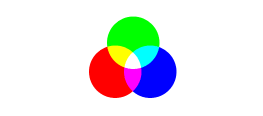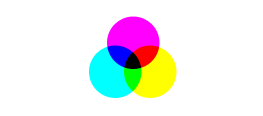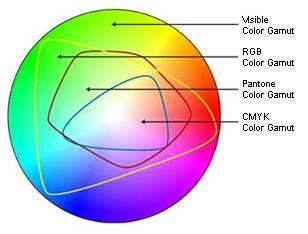CMYK versus RGB color spectrum
Whereas monitors emit light, inked paper absorbs or reflects specific wavelengths. Cyan, magenta and yellow pigments serve as filters, subtracting varying degrees of red, green and blue from white light to produce a selective gamut of spectral colors. Like monitors, printing inks also produce a color gamut that is only a subset of the visible spectrum, although the range is not the same for both. Consequently, the same art displayed on a computer monitor may not match to that printed in a publication. Also, because printing processes such as offset lithography use CMYK (cyan, magenta, yellow, black) inks, digital art must be converted to CMYK color for print. Some printers prefer digital art files be supplied in the RGB color space with ICC profiles attached. Images can then be converted to the CMYK color space by the printer using color management methods that honor profiles if present; this helps preserve the best possible detail and vibrancy.

Red, Green, Blue – Additive colors

Cyan, Magenta, Yellow – Subtractive colors
It can sometimes be difficult to visualize the reason for color shift in color space conversion. The best way to see the color differences between the CMYK and RGB color spaces is to look at a color gamut comparison chart. The chart to the left plots the visible color spectrum as the large “horse shoe” area, and within this is a plot of the CMYK colors, and the RGB colors. You can see that in some areas the RGB color space is “outside” that of the CMYK space. It is these colors that will be affected by a conversion from RGB to CMYK.

| Here are some examples of how various RGB colors convert to CMYK | |
 |
 |
| RGB colors (what you see on screen) |
CMYK colors (printing inks will do this) |
 |
 |
| RGB colors (what you see on screen) |
CMYK colors (printing inks will do this) |
Even most printers use same CMYK ink model that our printing presses use, the actual printouts are not identical, because each printer manufactures their inks a little differently. In addition, you cannot expect all the TVs and computer monitors display the completely same screen outputs. So, if we have difference on computer monitor outputs and different color display methods (RGB and CMYK) for both outputs, we cannot accept that customer’s output on their computer monitor as an accurate color guide.




